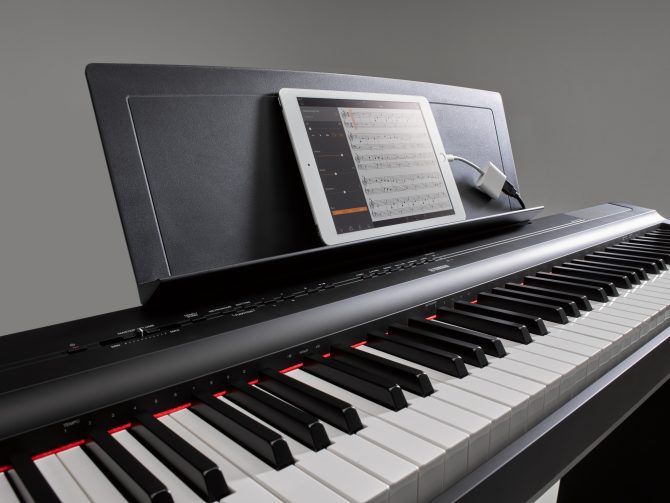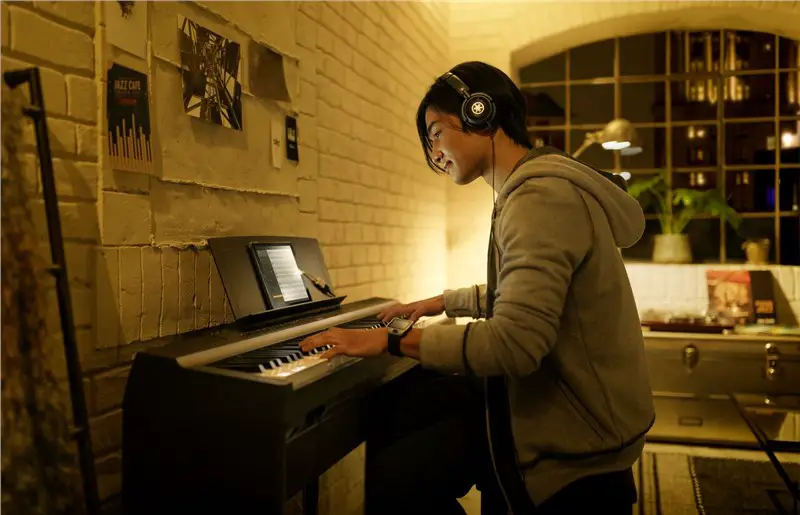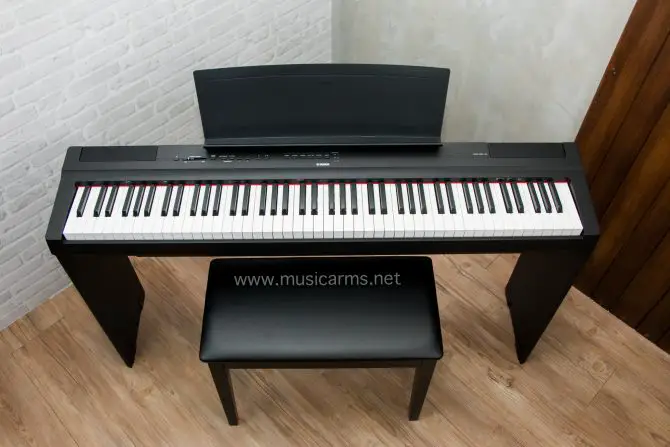
Please click image for more info
The Yamaha P125 is the latest midrange portable piano from this legendary company. It has functions and capabilities we haven’t yet seen from a Yamaha in this price range, and is a feature-rich upgrade from previous models.
In this review, we’ll look at everything the Yamaha P125 has to offer and see how it compares to the competition.
Overview of Yamaha P125

The Yamaha P125 is designed to give you all the experience and performance of an acoustic piano in a portable, easy-to-use package. It is capable of producing both the dynamic sound and natural piano touch response of an acoustic piano, without sacrificing a slim footprint or simplicity of use.
This model is a great keyboard for those who need to balance their desire for all the sound and feel of an acoustic piano, with advanced technologies and digital features, with the need to stay compact, portable, and affordable.
The Yamaha P125 is also compatible with the groundbreaking Smart Pianist iOS app, which makes the features and functions of the P125 even more accessible and customizable, expanding the capabilities of the piano and enhancing your experience as a musician.
Video Overview of Yamaha P125
Yamaha P125 FAQs
When did the Yamaha P125 come out?
The Yamaha P125 come out in 2018.
What are the dimensions of the Yamaha P125?
The dimensions of the Yamaha P125 are 1326 x 295 x 166 mm (52-3/16” x 11-5/8” x 6-9/16”)
What is the weight of the Yamaha P125?
The weight of the Yamaha P125 is 26 pounds/11.8 kg.
How much does the Yamaha P125 cost?
The Yamaha P125 costs $650 in Amazon but it may change depending on from where you are buying it.
How many keys does the Yamaha P125 have?
The Yamaha P125 has 88 keys.
How many sounds does the Yamaha P125 have?
The Yamaha P125 has 24 sound presets.
Where can I see a demo/test of the Yamaha P125?
You can see a demo/test of the Yamaha P125 in this link https://www.youtube.com/watch?v=GUVgnka93fg&feature=youtu.be
Where can I see an unboxing of the Yamaha P125?
You can see an unboxing of the Yamaha P125 in this link https://www.youtube.com/watch?v=p9ls8HWAvxM&feature=youtu.be
Where to buy the Yamaha P125?
One can buy Yamaha P125 from large shops like Walmart and Amazon.
How heavy are the keys in Yamaha P125?
Keyboards of Yamaha P125 with hammer action replicate the same playing characteristics of acoustic pianos. Like an acoustic piano, the bass keys are heavier while the treble keys have a lighter touch.
Yamaha P125: how is the feel?
Yamaha P125 uses the graded hammer standard to recreate the feel of a classical non-digital pianos. Graded means the piano keys feel heavier in the lower registers when you press them in comparison to the lighter weight felt in the higher registers.
What is the difference between a Yamaha P125 and Yamaha P125b?
Yamaha P125 and Yamaha P125b are the same piano or the same model and the word “B” here is used to only specify the color option for the piano so customer will know in what color their item will arrive and in term of specification or capabilities, they are exactly the same.
What is the difference between Yamaha P115 and Yamaha P125?
The similarities between two models are:
- Both models are designed to be about as portable as it gets when it comes to 88-key digital pianos.
- Both keyboards use weighted keys and the Intelligent Acoustic Control and the Pure CF Sound Engine for outstanding sound quality.
- They have polyphony of 192 notes.
- They have same recording system.
- Both of these digital pianos come with a metronome and a transpose function.
- Both of these pianos come with 5 different connection ports.
Their differences are:
- Price of Yamaha P125 is slightly higher than Yamaha P115.
- Yamaha P115 has one way speaker system but Yamaha P125 has two way speaker system.
- Yamaha P125 has 24 voices but Yamaha P115 has 14 voices.
- Yamaha P125 has 50 songs + 21 demo songs but Yamaha P115 has 50 songs + 14 demo songs.
- Yamaha P125 has 20 rhythms available. 6 more than is available on the Yamaha P115
- Both of these pianos come with their own unique apps. Yamaha P115 comes with Digital Piano Controller and the Yamaha P125 comes with the Smart Pianist app.
- P 115 can be controlled via free digital piano controller app but the app functionality is nowhere near to that Pianist App.
- The sound of P 125 is much more expressive and rich when compared with 115.
- 115 also lacks “Table EQ” feature. The Table EQ feature present more real and authentic acoustic piano sound even when played in flat surface instead of regular stand.
- While the P115 is made mainly for beginners and some intermediates, P125 is piano for most intermediate players.
How does the Yamaha P125 compare to the Yamaha P155?
The similarities of the Yamaha P125 and the Yamaha P155 are:
- Both models have 88 keys with Graded hammer standard (GHS) keyboard.
- Both of them have same touch sensitivity.
- They have connections of same auxiliary audio input and headphone output.
Their differences are:
- The Yamaha P155 has maximum 128 polyphony and 17 voices. The Yamaha P125 has maximum 192 polyphony and 24 voices.
- The Yamaha P125 has 21 demo songs and 50 piano songs but The Yamaha P155 has 50 songs presets.
- The Yamaha P155 has larger recording capacity.
- The Yamaha P155 uses General MIDI but The Yamaha P125 doesn’t use it.
- Yamaha P125 has two way speaker system but The Yamaha P155 has one.
- Yamaha P125 has 7 W x 2 amplifiers, The Yamaha P155 has 12W x 2 amplifiers.
- The Yamaha P155 has dimensions of 1,334mm (52-1/2″) x140mm (5-1/2″) x 351mm (13-13/16″) and weighs 18.6kg (41 pounds). Yamaha P125 has dimensions of 1326mm x 166mm x 295mm and weighs 11.8kg.
What is the difference between Yamaha P125 and Yamaha DGX-660?
Similarities of both models are:
- Both models have 88 keys with Graded hammer standard (GHS) keyboard.
- Both have level 3 touch sensitivity.
- Both models have same number of Maximum Polyphony.
- They use same power adopter
Differences between both models are:
- Yamaha P125 has 24 sounds presets. Yamaha DGX-660 has 554 sound presets.
- Yamaha P125 has 71 songs presets. Yamaha DGX-660 has 106 songs presets.
- Yamaha DGX-660 has 205 style preset which isn’t applicable for Yamaha P125.
- Yamaha P125 has 20 Rhythm Presets which isn’t applicable for Yamaha DGX-660.
- Practice Features: Yamaha P125 has Metronome; Yamaha DGX-660 has Lessons, Chord Dictionary, and Metronome.
- The Yamaha DGX-660 use General MIDI and XGlite but The Yamaha P125 doesn’t have such feature
- The Yamaha DGX-660 has maximum recording time of 80 minutes per song which isn’t applicable for Yamaha P125.
- The Yamaha DGX-660 uses both USB type A and B. Yamaha P125 uses only USB type B.
- The Yamaha DGX-660 uses 2 x 6 W amplifiers and 2 x 4.72″ / 12 cm+ 2 x 2″ / 5 cm round speakers. Yamaha P125 has 2 x 7 W amplifiers and 2 x 4.72″ / 12 cm +2 x 1.57″ / 4 cm round speakers.
- The Yamaha DGX-660 has dimensions of 55 x 5.8 x 17.6″ (1397 x 146 x 445 mm) and weigh 46.4 pounds (21 kg without stand). Yamaha P125 has dimensions of 52.2 x 11.6 x 6.6″ (132.6 x 29.5 x 16.8 cm) and weighs 26 pounds (11.8 kg).
- Yamaha P125 costs $70 less than The Yamaha DGX-660.
What is difference between Yamaha P125 and Yamaha P45?
Similarities between Yamaha P125 and Yamaha P45 are:
- Both the P45 and P125 have the full 88-keys and weighted action.
- They are both programmed to have the dynamic Yamaha sound.
- They are compact and lightweight pianos, both weighing just under twelve kilograms, so they are convenient for small spaces or if you need to move the piano around regularly.
- Both have level 3 touch sensitivity.
- The difference in their dimensions is very insignificant.
Differences between both models are:
- The P125 has an improved sound engine, featuring the Yamaha CFIIIS concert grand piano sampling.
- The P125 for more experienced players compared to Yamaha P45.
- There is a much higher polyphony on the P125; 192 notes are able to sound at once before notes start ‘dropping,’ compared to 64 on the P45, resulting in a richer, more resonant sound.
- The P125 has 24 voices, as opposed to the P45’s 10.
- The P125 has 71 songs presets. Yamaha P45 has 20 songs presets.
- Yamaha P125 has 20 Rhythm Presets which isn’t applicable for Yamaha P45.
- The P125 is compatible with a fixed stand and the full three pedals, necessary for players wanting extra dimension and expression in their playing.
- The P125 also has added benefits. You can record on the piano and transfer the file to an electronic device. You also have access to the Yamaha Smart Pianist app.
- Though they have same TRS Headphone Output but The P125 has extra auxiliary audio input.
- The P125 is $250 more expensive than P45.
Which is better: Yamaha P125 or Casio Privia PX870?
The similarities between both models are:
- Both the P45 and P125 have the full 88-keys and weighted action.
- Both have level 3 touch sensitivity.
- They have same types of round speakers.
The differences between the models are:
- Yamaha P125 has 24 sounds presets. Casio Privia PX870 has 19 sound presets.
- Yamaha P125 has 71 songs presets. Casio Privia PX870 has 70 songs presets.
- Yamaha P125 has maximum 192 polyphony notes but Casio Privia PX870 has 256 notes.
- Yamaha P125 has 20 Rhythm Presets which isn’t applicable for Casio Privia PX870.
- Though they have same TRS Headphone Output but The P125 has extra auxiliary audio input.
- Casio Privia PX870 uses both USB type A and B. Yamaha P125 uses only USB type B.
- Casio Privia PX870 has 2 x 20w amplifiers but Yamaha P125 has 2 x 7W amplifiers.
- Casio Privia PX870 has dimensions of 54.8 x 31.5 x 11.8″ (139 x 81 x 30 cm) and weighs 76.3 pounds (34.6 kg). Yamaha P125 has dimensions of 52.2 x 11.6 x 6.6″ (132.6 x 29.5 x 16.8 cm) and weighs 26 pounds (11.8 kg).
- Casio Privia PX870 costs $300 more than Yamaha P125.
It can’t be told which one is absolutely better. Though Casio Privia PX870 costs $300 more, it also has some unique features.
Yamaha P125 Specs
|
Specification |
Description |
|---|---|
|
Speakers |
4 in total |
|
Weight |
26 pounds |
|
Preset songs |
21 demo songs and 50 piano songs |
|
Number of song recordings |
One |
|
Tone Generation |
Pure CF Sound Engine |
|
Polyphony |
192 max polyphony |
|
Number of voices |
24 |
|
Number of track recordings |
Two |
|
Compatibility |
Compatible with Smart Pianist app (iOS only) |
|
Functions function |
|
|
Keyboard |
|
|
Effects |
|
|
Functions |
|
|
Auto Power |
Includes auto power off |
Who is the Yamaha P125 Most Suitable For?

The P125 has a lot of features that make it fantastic for musicians. The feel, sound, speakers, and operation of the P125 are closely modeled on a Yamaha acoustic grand piano, for a concert-like feel at home. But the Yamaha P125 weights just 26 pounds and has the line-out jacks musicians need to take their music on the road.
Registration memory lets you save and quickly restore your tones and settings to change your sound as needed. The ability to record MIDI, ACC, or WAV files directly from the piano, along with connectivity to apps and tools like GarageBand allow you to control and share your music. It’s easy to use the P125 to practice, record, and perform almost anywhere life takes you.
The Yamaha P125 is also great for teachers and students who want to learn how to play piano. While it has a lot of advanced digital features, it’s streamlined and easy to use, particularly with the addition of the Smart Pianist app. It has a lot of features that are ideal for skill building, like the metronome setting.
Duo keyboard mode lets you split the keyboard so each half has 44 keys and a middle C, ideal for sitting side-by-side and practicing together. With the built-in song library, you can turn off the left- or right-hand audio and play along with the music, or instead play along with anything in your iTunes music library.
What’s Included With the Yamaha P125?
The Yamaha P125 88 Weighted Key Digital Piano Bundle from Amazon comes with:

A Knox Gear adjustable double x keyboard stand: The sturdy design is reinforced for stability, with a sliding lock that allows it to stand at any height from 4 inches to 38 inches, and rubber caps to prevent slipping.
On Stage KSP100 keyboard piano style sustain pedal: full size piano-style pedal has a heavy-duty spring for better control and longevity with realistic dynamic resistance, an all metal base for stability, and a scratch-resistant cover.


A Knox Gear adjustable x style keyboard bench: folds flat for easy storage, adjusts from 19 inches to 24 inches in height, with a 2 inch seat cushion and capacity up to 250 pounds.
Yamaha P125 Features

|
FEATURE |
DESCRIPTION |
|---|---|
|
Compact keyboard |
The Yamaha P125 has a lot of high-performance features and capabilities for such a compact keyboard. |
|
Graded hammer |
The graded hammer standard provides the feel of an analogue piano, with keys that are more heavily weighted toward the low end of the keyboard, and lighter feeling on the high end.This is not only a satisfying feeling for experienced piano players, but it allows beginners to learn an authentic touch and fingering technique that translates easily to acoustic pianos. |
|
Matte finish |
The matte finish on the black keys provides a non-slip surface and absorbs moisture for better comfort over long playing. |
|
Dual/layers function |
The dual/layers function allows you to layer two piano voices together and play them at once, for a richer and more complex sound. |
|
Pure CF Sound |
The 24 voices of the Yamaha P125 include 4 grand piano voices, 4 electronic piano voices, 4 organ voices, harpsichord, clavichord, strings, choir, synth pad, and 4 bass voices. The 4 types of reverb allow the P125 to simulate a room, hall, or stage. |
|
Split keyboard function |
The split keyboard function allows you to virtually “split” the keyboard and play two instrument voices, one with each hand. You can even customize where the split occurs. |
|
24 Voices |
The 24 voices of the Yamaha P125 include 4 grand piano voices, 4 electronic piano voices, 4 organ voices, harpsichord, clavichord, strings, choir, synth pad, and 4 bass voices. The 4 types of reverb allow the P125 to simulate a room, hall, or stage. |
|
Polyphony of 192. |
A maximum polyphony of 192 provides endless opportunities to create rich, overlapping, sustained notes and voices in complex, multi-layered arrangements. |
|
21 Demo |
21 demo songs and 50 piano songs give a great opportunity to learn and practice everything the P125 is capable of. |
|
Intelligent Acoustic Control |
Enter your Intelligent Acoustic Control prevents a digital pianos from losing sound quality when played at a low volume (for example, practicing at home). IAC automatically adjusts speaker equalizer settings to compensate for speaker volume, and allows for more clarity and depth of sound, even when played quietly |
|
Record 2 song tracks |
The ability to record a song with 2 tracks and store it in onboard memory is nice, but for more than one song you will need to use the USB port and a computer to expand your recording and storage capabilities. |
|
“Duo” function. |
Duo mode allows the keyboard to be split and have two 44-key keyboards, each with their own middle C. This is perfect for lessons, where two players can sit side-by-side and play together. |
|
4 Speakers |
4 speakers provide more dimensional sound than the standard 2. The Table EQ feature balances the speakers to optimal acoustics when the P125 is set on a hard surface |
|
Features |
The Yamaha P125 is also compatible with Smart Pianist, an iOS app designed to help you make the most of a Yamaha keyboard. With the Smart Pianist app, you can:
|
Accessories for the Yamaha P125
A Carrying case |
|---|

If you need to transport your Yamaha P125, it’s best to get a carrying case. For short trips and easy or infrequent travel, the Yamaha Artiste Series keyboard bag for 88-note keyboards is an excellent choice, and reasonably priced. For frequent travel, air travel, and more frequent, rugged use, the Gator Cases Padded Keyboard Gig bag is highly recommended. It is made of heavy-duty ballistic nylon with reinforced riveted carrying handles. The adjustable padded straps securely hold a keyboard in place and protect it during transport, and it has convenient large #10 zippers.
Headphones |
|---|

The Yamaha P125’s 4 speakers are designed to deliver high quality, immersive sound. However, in a small space, you can’t always take advantage of the full range of these speakers, and may need to use headphones. While many people buy an adaptor so they can use their existing earbuds with a Yamaha P125, that isn’t the best choice for sound quality or isolation. You need headphones that deliver the best, most immersive sound to you, while eliminating background and external noise and distractions.
The best headphones for this are the Sony MDR7506 Professional headphones. They have built-in noise cancellation to reduce distractions, have fantastic sound, fold for easy portability, and are light weight for hours of comfortable use. The high-quality connectors ensure extra durability, and the generous, 9.8 foot cord gives plenty of length to reach to the headphone jack. These professional headphones are a great investment in the quality and enjoyment of your piano playing.
Pros & Cons of the Yamaha P125
|
PROS |
|---|
|
|
cons |
|---|
|
Yamaha P125 Manual
If you’d like to check out the nitty-gritty of the Yamaha P125, here’s a link to the model’s manual:
CLICK TO DOWNLOAD YAMAHA P125 MANUAL
An Alternative Product: Roland FP-30 vs Yamaha P125

The Roland FP-30 is the most commonly cited competitor to the Yamaha P125, and it makes sense to compare them. They have a similar size, capability, features, and price point. Unlike the Yamaha, though, the Roland FP-30 uses the PHA-4 standard for the keyboard feel, and has Roland’s proprietary SuperNATURAL sounds. In a head-to-head comparison, piano professionals agree that the PHA-4 standard is more realistic and closer simulates an acoustic piano than the Graded Hammer Standard used by the Yamaha P125.
And the SuperNATURAL technology goes beyond sampling, for sounds that are more expressive and emotive than is usually achieved in a digital piano. The Roland FP-30 is considered a near-pro-level digital piano in an accessible price range.
Advantages of the Roland FP-30

PHA-4 standard is better than the graded hammer standard in the Yamaha.
Built-in Bluetooth connectivity is more convenient than having to buy a Bluetooth accessory with Yamaha.
SuperNATURAL tones are more individual and varied than the Yamaha Pure CF sound engine.
Advantages of the Yamaha P125

192 max polyphony is greater than Roland’s 128
26 pounds is more portable than the 31 pound Roland FP-30
4 speakers in the Yamaha provide richer, more immersive, more realistic sound than the 2 speakers in the Roland
4 speakers in the Yamaha provide richer, more immersive, more realistic sound than the 2 speakers in the Roland
Yamaha P-125 – Full Demo with Gabriel Aldort
Merriam Music’s Yamaha P125 Review
Conclusion
The Yamaha P125 is an exceptional sounding and feeling digital piano, with rich, detailed, nuanced sound and expressive play.
It’s also a feature-rich digital piano, with a large library of voices and rhythms, tuning and transposing options, and capable of lush polyphony.
It’s also compatible with a sophisticated iOS app that will enhance your experience of the piano, making it easier to customize and store your settings, and helping you learn, practice, and play along with your favorite songs.

Yamaha P125 (click image for more info)
It does all this in a light weight, portable package. It’s an excellent choice for all kinds of musicians, whether you are practicing for a stage recital on a grand piano, writing and recording your own songs, or going on the road to share your music with the world.
The Yamaha P125 is the best of portable, digital pianos, modeled on the best of the full concert grand pianos, and a great choice for any musician or aspiring musician.
